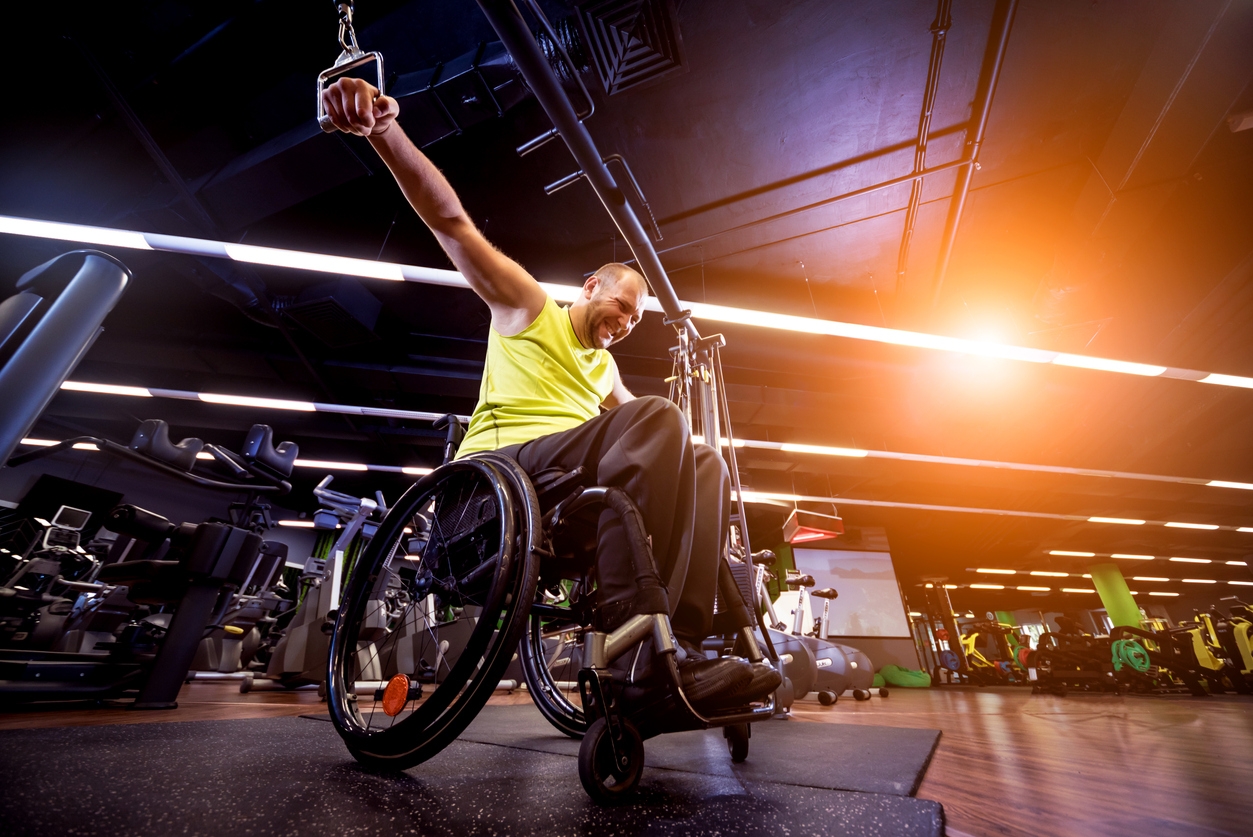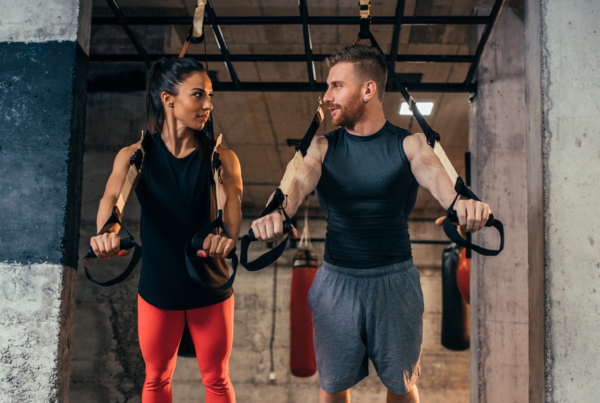Lisa Gombinsky Roach gives valuable insight into how the industry is changing to welcome clients with neurological conditions – and why you should consider working with this special population.
Once upon a time, we made a very silly assumption. We assumed that people with chronic neurological conditions were not going to be gym members and would never be our clients. We assumed this because we were living in a world where there was a narrow definition of health and fitness that did not include people with disabilities; because we were living under a medical model that said if you had a diagnosis you only belonged under the care of medical and allied health professionals, definitely not in gyms with personal trainers; because learning to be a fitness professional did not include discourse about different types of bodies; because gyms were not welcoming places for people who were different.
It is so exciting to be wrong in this assumption. It is exciting to see barriers start to come down and to see the fitness industry extending its reach and starting to include people with disabilities, diagnoses and differences. It is exciting to be alive in a time where we are seeing exercise being included in the medical prescription for management of most diseases and conditions. It is exciting to finally understand that people with disabilities are people with disabilities and that the exercise guidelines for people are therefore applicable to people with disabilities. It is even more exciting to understand that these people are the people who most need our expertise and creativity, and that, whether we are just supporting one client or building our careers around these populations, the fitness industry has something remarkable to offer.
Here are some tips for where to start:
-
Don’t be a coward, don’t be a cowboy
I want to start by telling you that it is OK to be unsure or intimidated or worried that you will do something wrong. Don’t let these feelings prevent you from working with someone who needs you – they will help you do right by your clients. Do your research, liaise and consult with other professionals involved with your client, respect your own limitations, and learn and grow. We often say that people don’t care what you know until they know that you care. I want to tell you that caring isn’t enough – show your client that you care by taking the time to learn about their condition. You don’t need to be an expert but you do need to make an effort.
-
There are no rules
We know that no two people are alike. That is true for boring old neuro-typical people and it is even more true for people with neurological conditions. Brains are complicated, people are complicated, conditions affecting individual people’s brains are complicated, and individual manifestations of conditions, symptoms and disease progression can vary. Be prepared for a bit of chaos and unpredictability – not just from one person to the next person but for one person from one minute to the next. Go in knowing that the work will be challenging but rewarding, that there will be ups and downs, wins and losses, and a fair amount of unruliness and imperfection because that is the nature of disordered central nervous systems and degenerative brain diseases.
-
Start with the person
Start with the person, not the diagnosis. As personal trainers, this is something we are actually really good at – don’t let the presence of a disability or diagnosis get in the way of this. Meet each individual where they are at; find out what their personal goals, dreams and needs are, and what motivates them. Look for the why behind the what. Find out what their strengths and existing solutions are; how they normally do things and manage their bodies. Talk to them about what isn’t working and where they are struggling. Be blown away by the person with no arms who lights her cigarette and smokes it using her feet, or whose hearing aid connects to their mobile phone, or who makes it to the gym despite crushing fatigue. Don’t assume you know what they do or don’t want to work on – someone who comes to you in a wheelchair might want to walk and might want to lose weight and might want to train for wheelchair rugby and might want help with hip pain. Be creative with problem solving, be willing to get it wrong and be prepared to go back to the drawing board.
-
Don’t blame it on the boogie
It is really easy to sweep everything under the blanket of someone’s diagnosis or disability. Doctors actually do it all of the time with these clients, and this is understandable because some of these conditions are complex and can have a huge array of symptoms or presentations. I’m working with someone at present who was told for years that her shoulder pain was due to her Parkinson’s and, when I pushed for her to get a scan, it revealed a serious rotator cuff injury and bursitis. I read a study recently talking about increased risk of metabolic syndrome for people with cerebral palsy who are wheelchair users – cerebral palsy and wheelchairs don’t cause metabolic syndrome but being sedentary for decades with a poor diet certainly might. Yes, neurological conditions will cause some things, but we can help negate secondary complications that exacerbate someone’s condition or amplify impairment.
-
Watch that tone
People with neurological conditions often have ‘abnormal’ muscle tone – in quotes because the term itself assumes there is such a thing as ‘normal’. We can expect to see too much muscle tone, too little muscle tone, inconsistent tone or changing tone. Disassociate your understanding of the word ‘tone’ from your understanding of strength and weakness – in fact, high tone is almost always associated with weakness. Understand that, while we might observe muscle tightness or joint laxity, the source of the abnormal tone is the brain. Instead of judging whether tone is normal or abnormal, look at whether abnormal tone is functional or dysfunctional. For example, someone might have high tone in their legs that enables them to stand – so is functional – but it makes it hard to get their legs into trousers – so is dysfunctional. If we know that the tone comes from their brain and that we therefore can’t cure them of this high tone by stretching for a few seconds at the start of a workout and, even if we did, they would lose their ability to stand, we can concentrate on looking for solutions to putting on trousers despite having high tone.
-
A fine balance
Don’t assume that all balance issues come from weak core muscles. Yes, most people could do with some additional core strengthening but we can do better when we approach balance issues for people with neurological conditions. For example, if somebody says their balance is fine when the lights are on but when they get up in the night they struggle, perhaps we are looking at a reliance on visual feedback for balance vs a weak core. When working on balance, we need to consider proprioception, sensory issues, what part of the brain is affected by the condition, vestibular issues, muscle imbalances, asymmetry, abnormal tone, postural issues, slower reaction time, difficulty with dual tasking, blood pressure issues and medication. There is so much more scope for helping people improve their balance than just focusing on holding planks.
-
For I can help falling …
My clients all know that ‘falling’ is the ‘f-word’ – in fact, even when they find themselves on the floor unexpectedly, I remind them of our no falling policy. Yes, I do everything that I can to help people improve balance and strength in an effort to prevent falls. However, I also teach fall management – you only need to watch a judo match or a rugby game to know that there are ways of falling that minimise risk of serious injury. I teach people how to get up from the floor, and how to help someone who has fallen in a way that is safer for both and promotes dignity and independence for the person who has fallen, while minimising the risk of being further injured by being badly helped up. I work to help people be less afraid of falling, with the knowledge that some people stop walking because they are afraid of falling and many are more afraid of not being able to get up than of getting hurt. There is dignity in risk. The real world has uneven surfaces and moving obstacles; there are desirable things on the ground in the real world, such as grandchildren and gardens and pets. I want my grandfathers with Parkinson’s to be able to walk out on open fields to watch their granddaughters score their first goal, not to miss out because they are afraid.
-
Getting from A to B with a neurological condition
For able-bodied people, position changes happen naturally; we don’t have to think about them. While we recognise that a squat is a part of standing up, we often can’t go further in the details of all of the small movements that make up position changes. As trainers, we are so good at the mechanics of movements in relation to exercises. We can break exercises into teachable components, yet we will struggle to think through the chain of movements that are needed to get from lying in bed to sitting on the toilet. The reason is simple – we have never had to think about it. Think about functional mobility and position changes as they pertain to each individual. Is there something that needs tweaking because it is not efficient or no longer working? Something they have always wanted to do independently? Before you do that, I would first challenge you to work through how you personally carry out basic position changes – how do you stand up from a low squishy sofa or roll over in bed? How do you stand up from the floor or get a spoonful of hot soup into your mouth? How do you walk? I assure you, it is not as simple as putting one foot in front of the other.
-
Identify barriers
It is easy to think about physical barriers that prevent people from accessing a building or a piece of equipment or other aspect of our gym facility. While physical access is important, there are other barriers that we must also consider, in order to understand what prevents people with neurological conditions from exercising. For example, people with Parkinson’s often struggle with cluttered spaces, and people with MS often struggle with heat. A tidy gym and an air conditioner might be game changers. Some people struggle with crushing fatigue and may have very limited times in the day where exercise is an option. Some people will have cognitive challenges in addition to their physical challenges. Some people are coping with stress, apathy, anxiety and/or depression. Some will lack confidence; some will be really self-conscious. Some will have continence issues. Some will be battling myths about exercise which might be coming from a doctor or a well-intentioned family member. It is impossible to pre-emptively address all of these; try to think beyond the ramp leading to the door to understand what stops people from coming in.
-
Work from your heart, wear your business hat
I don’t have the answer to how you balance out a genuine desire to help someone with the running of your business. I don’t have the answer to the dilemma of offering services to people who need them most but that only some can afford. The honest truth is that, while there will be lots of people who can afford you, money will be an issue for many. While this is true of the general population, it is a much bigger issue in disability – that is fact. While you may choose to do some pro bono work, you should not feel obliged. You are a valuable professional; your contribution makes a huge difference, you deserve to be paid for your time and services, and the more specialised you are the more your time is worth.
I raise this here because, while there is no right or wrong answer, there is certainty that, if you open your business to this population, the issue will come up. How can you make it work? What funding can you help someone access or can your services qualify for? Can you include someone in a more cost-effective way such as a group? Does working with that person showcase your talents and attract other clients into your services? Is that person’s parent or spouse also a potential client? Is there some bartering you can do?
I am very proud to have been asked to write this, because it means you are interested in disability and that, as an industry, we are growing and expanding. We are opening our gyms and our hearts to people who need us most. In the words of one of my favourite octogenarians, “I don’t expect exercise to cure me of Parkinson’s, but I know it makes my journey through life with Parkinson’s a better one.” I look forward to hearing about your trials and tribulations with this amazing, special population.
Wanting to learn more? Why not choose one of our Specialist Populations CPD courses? There are loads to choose from
Also, have you checked out our related blogs?… Fit for purpose: Do the people in our classes reflect the people in our community? byRashmi Becker MBE and Accessible fitness for visually impaired clients.
Author Bio:
 Lisa Gombinsky Roach is the head coach and founding director of Counterpunch Parkinson’s and a senior conductive educator, specialising in teaching movement strategies and skills to people with motor disorders. She has been working in this field for over 20 years in various group and private rehabilitation settings in countries including NZ, Australia, Norway, Canada and England. Lisa is also a personal trainer, working exclusively with people with disabilities in clinical and mainstream fitness settings.
Lisa Gombinsky Roach is the head coach and founding director of Counterpunch Parkinson’s and a senior conductive educator, specialising in teaching movement strategies and skills to people with motor disorders. She has been working in this field for over 20 years in various group and private rehabilitation settings in countries including NZ, Australia, Norway, Canada and England. Lisa is also a personal trainer, working exclusively with people with disabilities in clinical and mainstream fitness settings.








